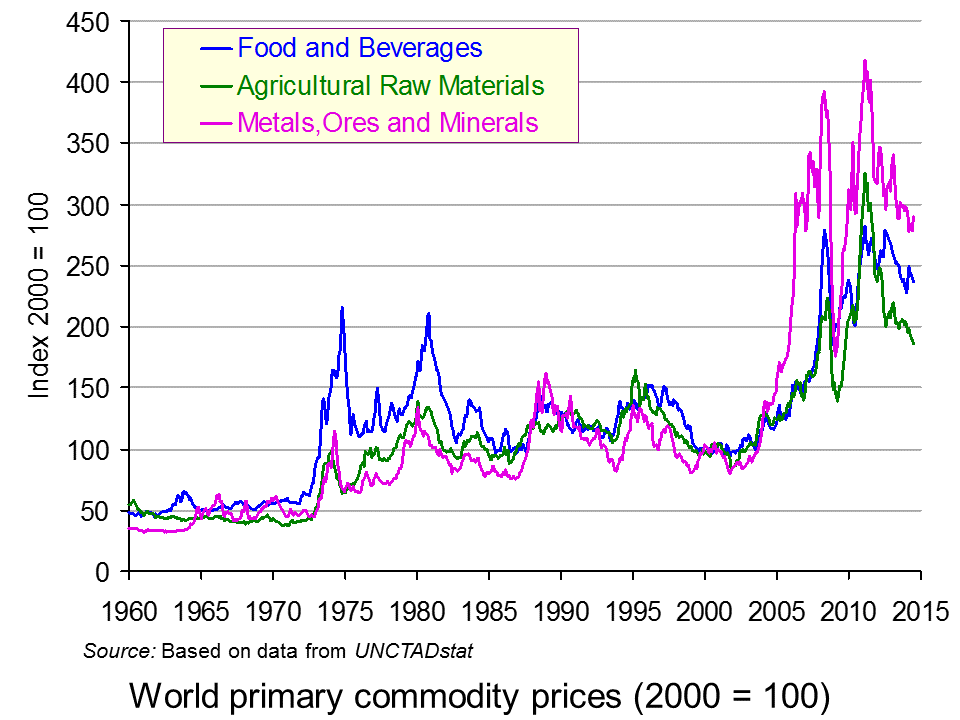 Commodity prices have been falling for the past three years and have reached a four-year low. Since early 2011, the IMF overall commodity price index (based on 2005 prices) has fallen by 16.5%: from 210.1 in April 2011 to 175.4 in August 2014. The last time it was this low was December 2010.
Commodity prices have been falling for the past three years and have reached a four-year low. Since early 2011, the IMF overall commodity price index (based on 2005 prices) has fallen by 16.5%: from 210.1 in April 2011 to 175.4 in August 2014. The last time it was this low was December 2010.
Some commodity prices have fallen by greater percentages, and in other cases the fall has been only slight. But in the past few months the falls have been more pronounced across most commodities. The chart below illustrates these falls in the case of three commodity groups: (a) food and beverages, (b) agricultural raw materials and (c) metals, ores and minerals. (Click here for a PowerPoint of the chart.)
Commodity prices are determined by demand and supply, and factors on both the demand and supply sides have contributed to the falls.
With growth slowing in China and with zero growth in the eurozone, demand for commodities has shown little growth and in some cases has fallen as stockpiles have been reduced.
On the supply side, investment in mining has boosted the supply of minerals and good harvests in various parts of the world have boosted the supply of many agricultural commodities.
But in historical terms, prices are still relatively high. There was a huge surge in commodity prices in the period up to the financial crisis of 2008 and then another surge as the world economy began to recover from 2009–11. Nevertheless, taking a longer-term perspective still, commodity prices have risen in real terms since the 1960s, but with considerable fluctuations around this trend, reflecting demand and supply at the time.
Articles
Commodities Fall to 5-Year Low With Plenty of Supplies Bloomberg Businessweek, Chanyaporn Chanjaroen (11/9/14)
Commodity ETFs at Multi-Year Lows on Supply Glut ETF Trends, Tom Lydon (11/9/14)
 What dropping commodity prices mean CNBC, Art Cashin (11/9/14)
What dropping commodity prices mean CNBC, Art Cashin (11/9/14)
Goldman sees demand hitting commodity price DMM FX (12/9/14)
Commodity price slump is a matter of perspective Sydney Morning Herald, Stephen Cauchi (11/9/14)
Commodities index tumbles to five-year low Financial Times, Neil Hume (12/9/14)
Commodities: More super, less cycle HSBC Global Research, Paul Bloxham (8/1/13)
Commodity prices in the (very) long run The Economist (12/3/13)
Data
IMF Primary Commodity Prices IMF
UNCTADstat UNCTAD (Select: Commodities > Commodity price long-term trends)
Commodity prices Index Mundi
Questions
- Identify specific demand-and supply-side factors that have affected prices of (a) grains; (b) meat; (c) metal prices; (d) oil.
- Why is the demand for commodities likely to be relatively inelastic with respect to price, at least in the short term? What are the implications of this for price responses to changes in supply?
- Why may there currently be a ‘buying opportunity’ for potential commodity purchasers?
- What is meant by the ‘futures market’ and future prices? Why may the 6-month future price quoted today not necessarily be the same as the spot price (i.e. the actual price for immediate trading) in 6 months’ time?
- How does speculation affect commodity prices?
- How does a strong US dollar affect commodity prices (which are expressed in dollars)?
- How may changes in stockpiles give an indication of likely changes in commodity prices over the coming months?
- Distinguish between real and nominal commodity prices. Which have risen more and why?
- How do real commodity prices today compare with those in previous decades?
